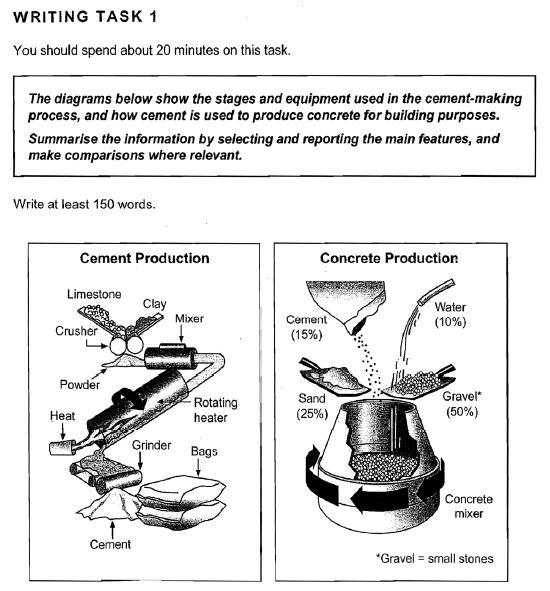Below is a sample band 9 answer to a process task 1 question on concrete production.

Source: Cambridge English IELTS Past Papers.
Question– The diagrams below show the stages and equipment used in the cement-making process, and how cement is used to produce concrete for building purposes.
Answer
The diagrams illustrate the phases and apparatus to make cement and how cement is utilised in the production of concrete for construction.
The production of cement involves a 5 stage, linear process that begins with the mixing of raw materials and culminates in the packaging of new cement. Making concrete is a simpler process that involves mixing four ingredients in a concrete mixer.
Limestone and clay are crushed and the resulting powder is then mixed before being passed through a rotating heater. Once heated this mixture travels over a conveyor belt and is ground through a grinder. Now that the cement has been produced, it is packaged and transported to a building site where it can be used to make concrete.
Concrete is made up of half gravel, quarter sand, 10% water and 15% cement. All of these are added together in a cylindrical drum and rotated until concrete is yielded.
(151 words)
Advice
The first paragraph simply paraphrases the question. This is done through using synonyms.
The second paragraph gives two overview sentences. An overview gives the examiner an overall picture of what is happening. You will notice that I have mentioned:
- How many stages there are;
- How raw materials were used;
- If it is linear or cyclical;
- what happens in the beginning; and
- what is the result?
I have split the overview into two sentences because there are two separate stages.
The third paragraph looks at cement production in much more detail than the overview. The examiner is looking for your ability to highlight the main features and sequence them effectively.
The fourth paragraph details the process of concrete production. This is a much simpler process and does not require so much sequencing. There are some percentages so it does allow us to show the examiner that we can use the language of proportions instead of just repeating all of the numbers.



